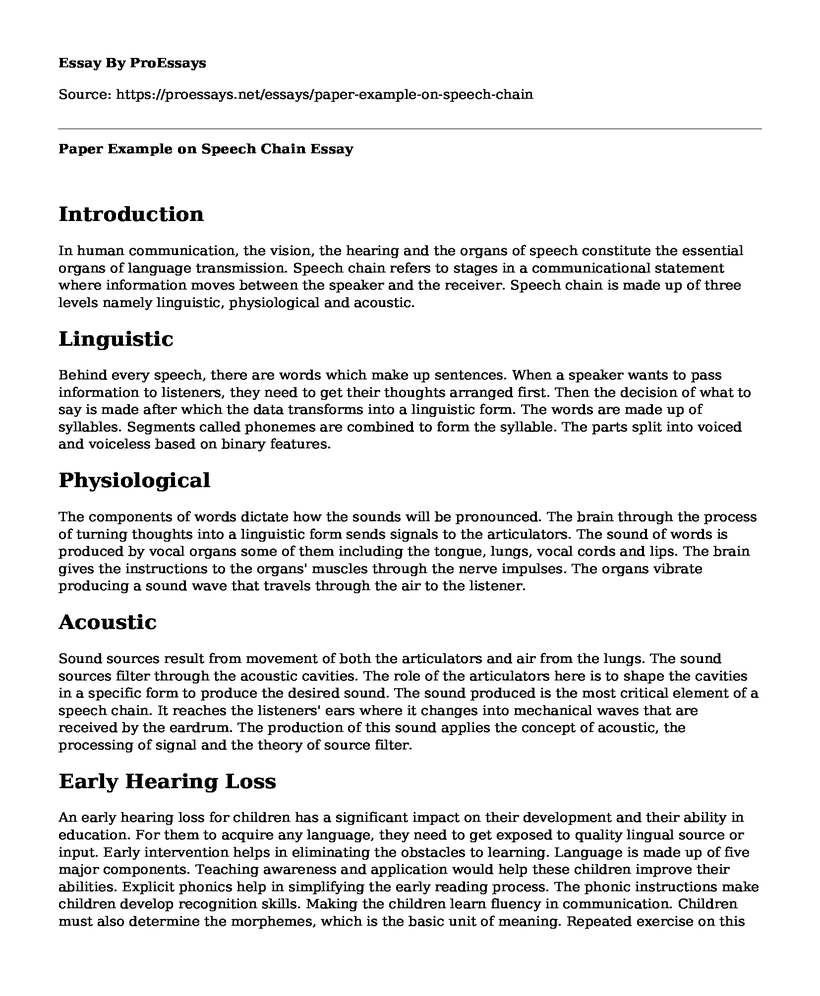Introduction
In human communication, the vision, the hearing and the organs of speech constitute the essential organs of language transmission. Speech chain refers to stages in a communicational statement where information moves between the speaker and the receiver. Speech chain is made up of three levels namely linguistic, physiological and acoustic.
Linguistic
Behind every speech, there are words which make up sentences. When a speaker wants to pass information to listeners, they need to get their thoughts arranged first. Then the decision of what to say is made after which the data transforms into a linguistic form. The words are made up of syllables. Segments called phonemes are combined to form the syllable. The parts split into voiced and voiceless based on binary features.
Physiological
The components of words dictate how the sounds will be pronounced. The brain through the process of turning thoughts into a linguistic form sends signals to the articulators. The sound of words is produced by vocal organs some of them including the tongue, lungs, vocal cords and lips. The brain gives the instructions to the organs' muscles through the nerve impulses. The organs vibrate producing a sound wave that travels through the air to the listener.
Acoustic
Sound sources result from movement of both the articulators and air from the lungs. The sound sources filter through the acoustic cavities. The role of the articulators here is to shape the cavities in a specific form to produce the desired sound. The sound produced is the most critical element of a speech chain. It reaches the listeners' ears where it changes into mechanical waves that are received by the eardrum. The production of this sound applies the concept of acoustic, the processing of signal and the theory of source filter.
Early Hearing Loss
An early hearing loss for children has a significant impact on their development and their ability in education. For them to acquire any language, they need to get exposed to quality lingual source or input. Early intervention helps in eliminating the obstacles to learning. Language is made up of five major components. Teaching awareness and application would help these children improve their abilities. Explicit phonics help in simplifying the early reading process. The phonic instructions make children develop recognition skills. Making the children learn fluency in communication. Children must also determine the morphemes, which is the basic unit of meaning. Repeated exercise on this would help children in creating more significant words. After learning how to create base words, the children need to know how to arrange the words to make sensible sentences. This ability starts with creating simple sentences. Semantics goes beyond the literal meaning of phrases. Semantics occur on higher levels of learning. Conversations vary from one group of people to another. The language is either formal or informal. This style of language use is pragmatics. Children with hearing loss will need extra support in differentiating between word meaning and a word label.
For this reason, an individual teaching plan must apply. This plan will help the children grow according to their ability as each student gets personal attention. Understanding the adverbial system is an essential requirement for higher-level progress. For children to improve on this, carrying out many assessments would help. Staff with high qualifications best fits this role. The teaching Staff should also seek professional consultation from specialists to offer maximum assistance in communication. The teachers should learn and observe the unique hearing ability of each child for effective aid.
Many children with hearing loss may find language complex as it involves constructing more significant sentences. Technology that supports learning has been seen to assist in sound amplification. Professional advice from an audiologist is considered for the right choice of device. Staff helping the student should also use strategies that make communication easy. The plans include class notes to enable the students to follow speakers spoken or signed dialogue. The classroom environment should be efficient in matters promoting communication and information accessibility. Noise in the room must be reduced to avoid distractions.
Cite this page
Paper Example on Speech Chain. (2022, Jul 27). Retrieved from https://proessays.net/essays/paper-example-on-speech-chain
If you are the original author of this essay and no longer wish to have it published on the ProEssays website, please click below to request its removal:
- How Marriage is No Longer Viable in Western Culture? - Paper Example
- Essay Sample on Contemporary Views on Marriage
- Essay on Strategic Communication: Exploring Fenton and Career Opportunities
- Effective Communication: A Roadmap to Success for Wheelie - Research Paper
- Essay Example on Gender Parity: The Emergence of Work-Life Balance
- Essay Sample on Ethical Principles: Defining Right and Wrong
- Essay on Fostering Vision and Mission Integration in Fine View School: Strategies and Communication Approaches







